| Article ID | Journal | Published Year | Pages | File Type |
|---|---|---|---|---|
| 8116769 | Renewable and Sustainable Energy Reviews | 2015 | 20 Pages |
Abstract
The residential sector consumes a significant amount of energy worldwide. Therefore, it is important to study, analyse and implement bioclimatic architectural systems that contribute to the reduction of energy consumption while considering the possible construction solutions offered at both passive and active levels. The present study conducted a comprehensive analysis that was stratified into three large blocks. The first block examined the concept of bioclimatic architecture. The second examined the bioclimatic architecture construction strategies as a function of each climate zone with the objective of achieving the greatest climate comfort level within a specific building. Fourteen climate zones were established and recommended according to the possible strategies that would facilitate reductions in energy consumption. The third block analysed the principal scientific research trends in this field and highlighted the use of vernacular architecture strategies, experimentation with bioclimatic architecture construction, application of innovative bioclimatic architecture strategies, promotion of bioclimatic architecture, use of bioclimatic architecture in urban planning, inclusion of bioclimatic lessons in study plans and development of energy saving technologies to support bioclimatic architecture. The extensive review described in this paper allowed us to conclude that certain bioclimatic architecture strategies that have been adopted in specific countries could be exported to other areas with similar climates because they were proven to be good functional design strategies that resulted in large energy saving measures (each in its corresponding climate) related to solar protection, humidification or temperature increases.
Related Topics
Physical Sciences and Engineering
Energy
Renewable Energy, Sustainability and the Environment
Authors
Francisco Manzano-Agugliaro, Francisco G. Montoya, Andrés Sabio-Ortega, Amós GarcÃa-Cruz,
